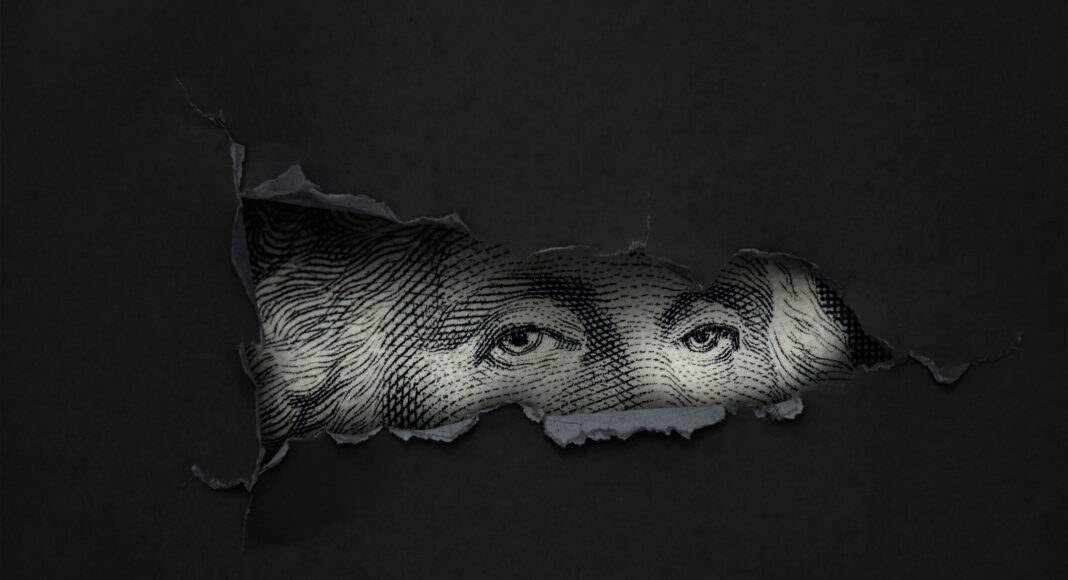New research on undisclosed and unlimited political contributions, or dark money, exposes the increasing role that such funds play in U.S. elections.
Undisclosed and unlimited political spending from special interest groups, termed dark money, now pours into U.S. federal elections and influences voters. Two key legal decisions in 2010 opened the floodgates for dark money. In January of that year, the decision by the U.S. Supreme Court on Citizens United v. FEC overruled previous prohibitions on election spending and related communications by corporations. Later in the year, the decision on SpeechNOW.org v. FEC removed contribution limits on independent expenditures. Should political contributions be fully protected by the First Amendment or do they erode trust in institutions? These tensions lie at the core of the ongoing debate about political contributions in the U.S.
We have a new paper studying dark money and its role in U.S. federal elections. Dark money groups are organized as 501(c) nonprofits at the IRS. There are two main features of political spending by these groups. First, they are not required to provide any information on their donors and only report limited financial information, generally after elections occur. Second, dark money groups face no limits on political spending that does not advocate for particular candidates (“soft money”), though they are limited in spending to directly support specific candidates (“hard money”). The complex structures of dark money groups and transfers of money between these group make it challenging, and often impossible, for citizens to identify dark money spending before voting.
Figure 1: Dark Money Inflows and Outflows
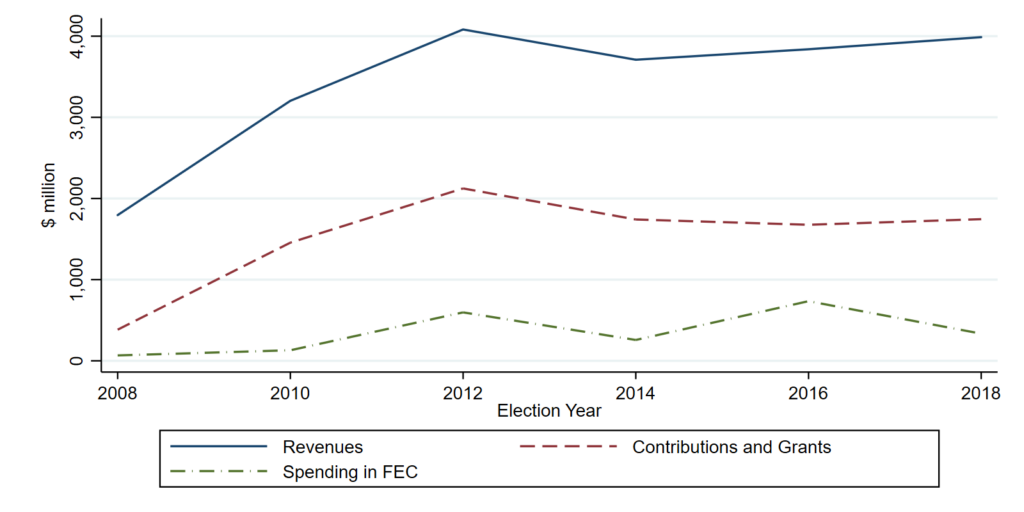
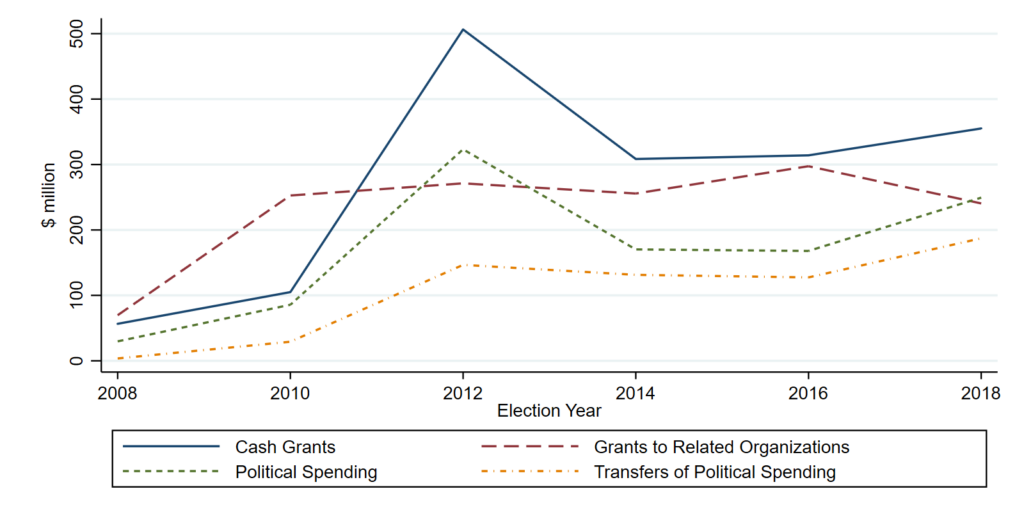
By its nature, dark money is difficult to observe and link to candidates. We manually identify dark money groups in Federal Election Commission (FEC) data and collect their public IRS tax filings. Figure 1, Panel A, shows that these groups received $2 billion to $4 billion during the 2008 to 2018 election cycles. The striking gap between the money raised by dark money groups and spending tracked in the FEC data suggests that only the tip of the iceberg is observed. In Panel B, we find these groups commonly transfer capital to other 501(c) organizations and that these other groups are politically active. When looking at political contributions in the FEC data, spending has markedly increased for congressional and presidential elections over the past decade. We also compare dark money spending to political capital provided by firms, labor, and trade groups. Spending by these other special interest groups is mostly flat, while dark money has soared over recent election cycles.
Figure 2: Types of Spending
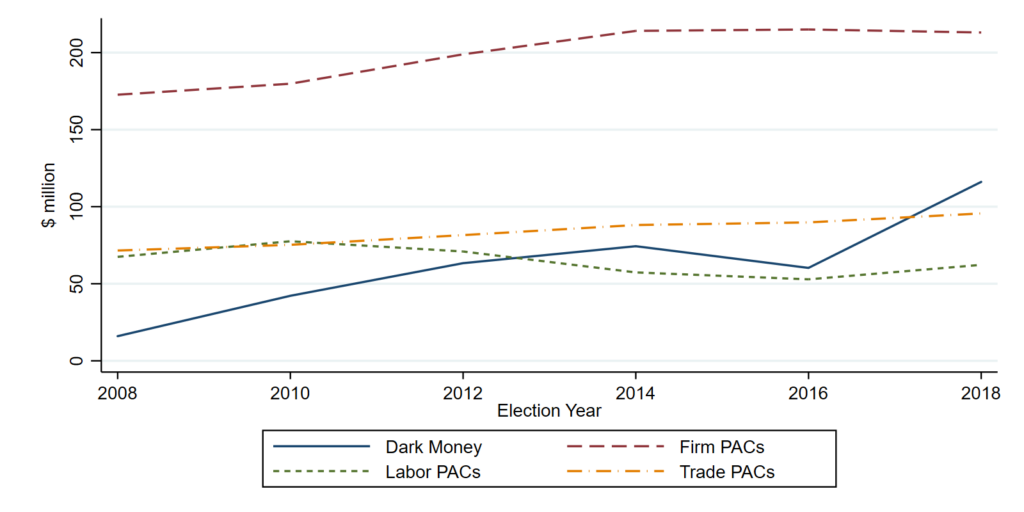
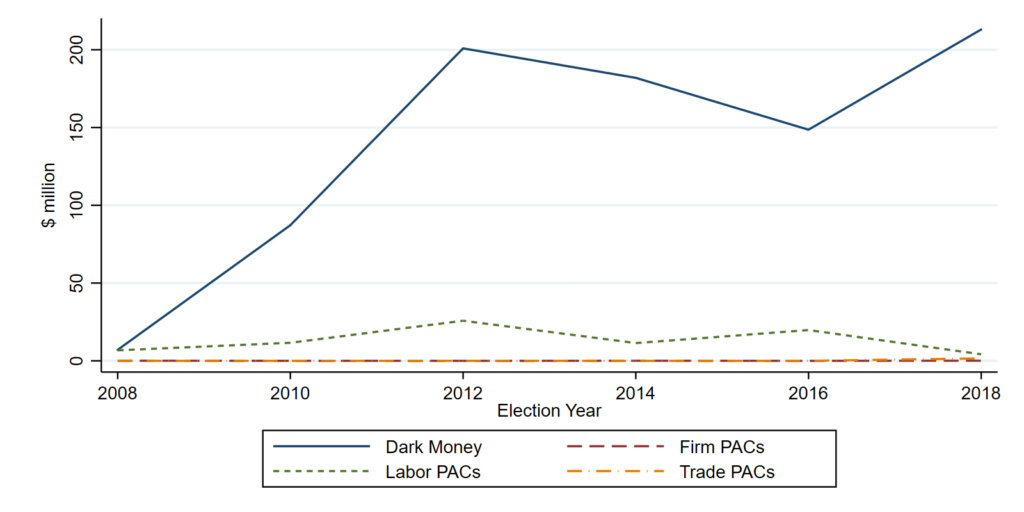
How do dark money groups spend their political capital? We track contributions by special interest groups starting before the Citizens United decision. Political spending can support a contributor’s preferred candidate or fund expenditures against the opponents in an election. Figure 2 shows spending to support candidates in Panel A and against candidates in Panel B. Proportionally, around two-thirds of dark money is spent against candidates and the remaining one-third is used to support candidates. This remarkedly differs from firm, labor, and trade groups that predominantly use political contributions to support their preferred candidates. With the rise of attacks ads and concerns of partisanship, this highlights the prominent role potentially played by dark money groups.
Unlike other special interest groups that engage in direct political spending, dark money groups frequently make contributions or grants to other related dark money organizations. Transferring political capital to other groups increases the likelihood that dark money contributions are not detected by voters, particularly prior to elections. Notably, capital contributed to these other organizations is not included in a dark money group’s political expenditures, though recipient organizations can use it for political spending. In our sample of tax filings, contributions and grants transferred to other 501(c) organizations totaled $3 billion. By churning contributions, dark money organizations are effectively able to circumvent political contribution thresholds at the FEC, in addition to providing donor anonymity.
As dark money groups are not required to disclose their donors, little is known about who contributes and how much particular donors provide. One potential source of funds for these groups is firms. During our sample period, 681 firms constitute the S&P 500 at some point and 129 firms report contributions to dark money groups (19% of these firms). The number of firms and the frequency of contributions increases by about five-fold from 2010 to 2017. Since disclosures are voluntary, this could understate the extent of firm contributions to dark money groups.
Figure 3: Map of Dark Money Spending
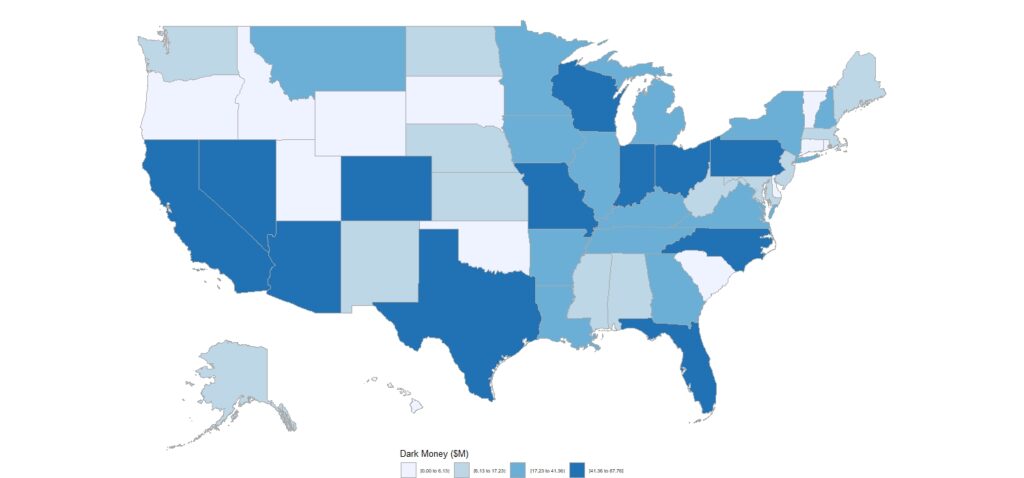
What are the types of elections and voters targeted by dark money spending? First, dark money flows to the most competitive elections. We measure competitiveness based on pre-election ratings from the Cook Political Report and the margin of victory. Second, we find that dark money is deployed in areas where citizens face less information based on newspaper circulation and in locations with greater inequality. This suggests that political contributions from dark money groups could be influential and affect elections, targeting electorates that may be more responsive to its spending. Figure 3 shows the geography of dark money over the past decade. The blue shading indicates the amount of spending in a particular state, with darker shades representing higher spending. Interestingly, and also consistent with our results, dark money often flows to swing states.
The crucial question is whether voters are swayed by dark money spending. We hand collect political advertising from the Federal Communications Commission (FCC). In a particular congressional district, some voters might be exposed to different political ads by different dark money groups in the same election cycle. We use this variation to study the effect of dark money groups on voting, turnout, and who wins. We find that ads supported by dark money groups increase the number of votes received by a candidate. While turnout also increases, the effect is relatively smaller and suggests that dark money also influences which candidates voters support. Additionally, dark money advertising seems to increase the likelihood of winning an election.
In the past decade since the two landmark Supreme Court decisions on campaign finance, our paper provides the first academic evidence about undisclosed and unlimited spending in federal elections. Dark money now dominates political spending by special interest groups and primarily flows against candidates. Ads sponsored by dark money sways voters and elections. Policymakers, including the U.S. Congress, frequently debate legislation about disclosures of political spending. Our results highlight the role of undisclosed political contributions in U.S. elections and the potential importance of more transparency.
Read more about our disclosure policy here.





